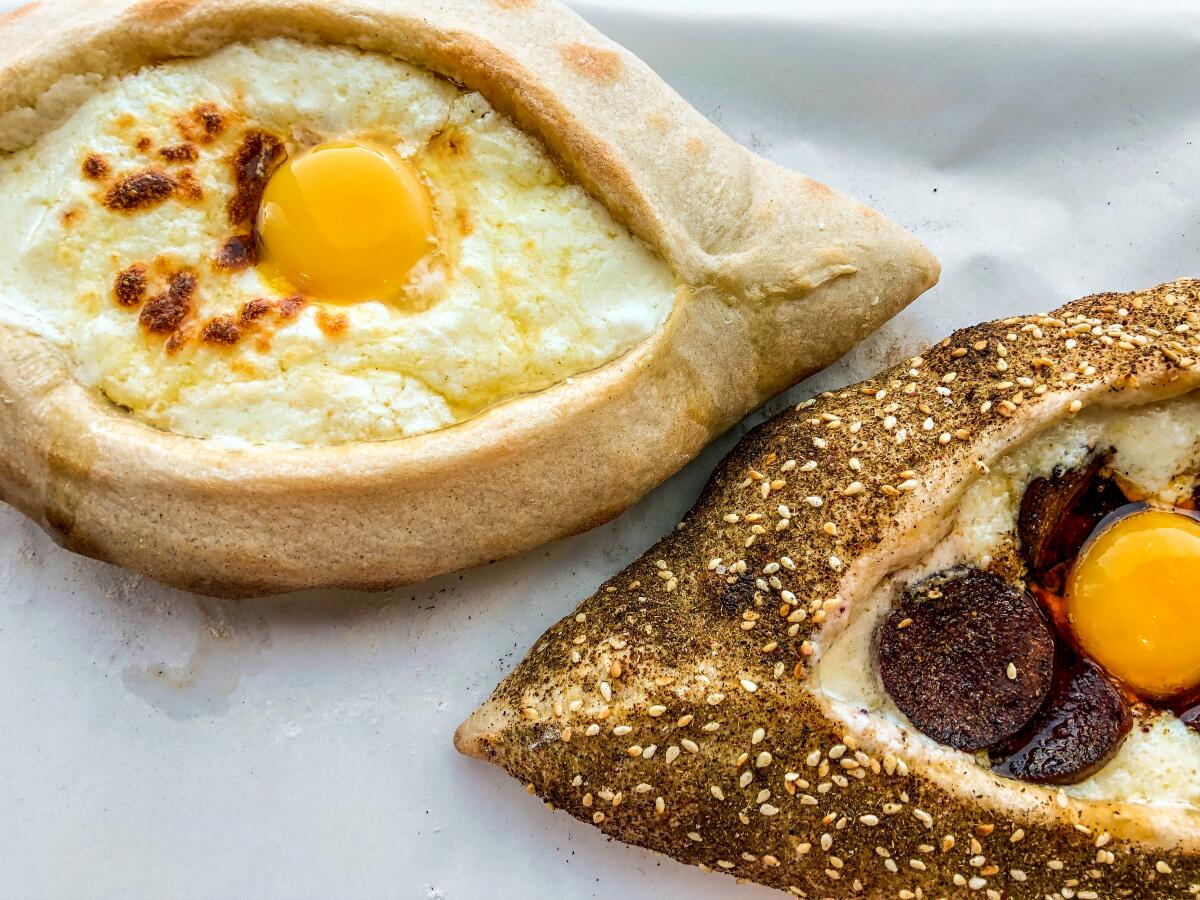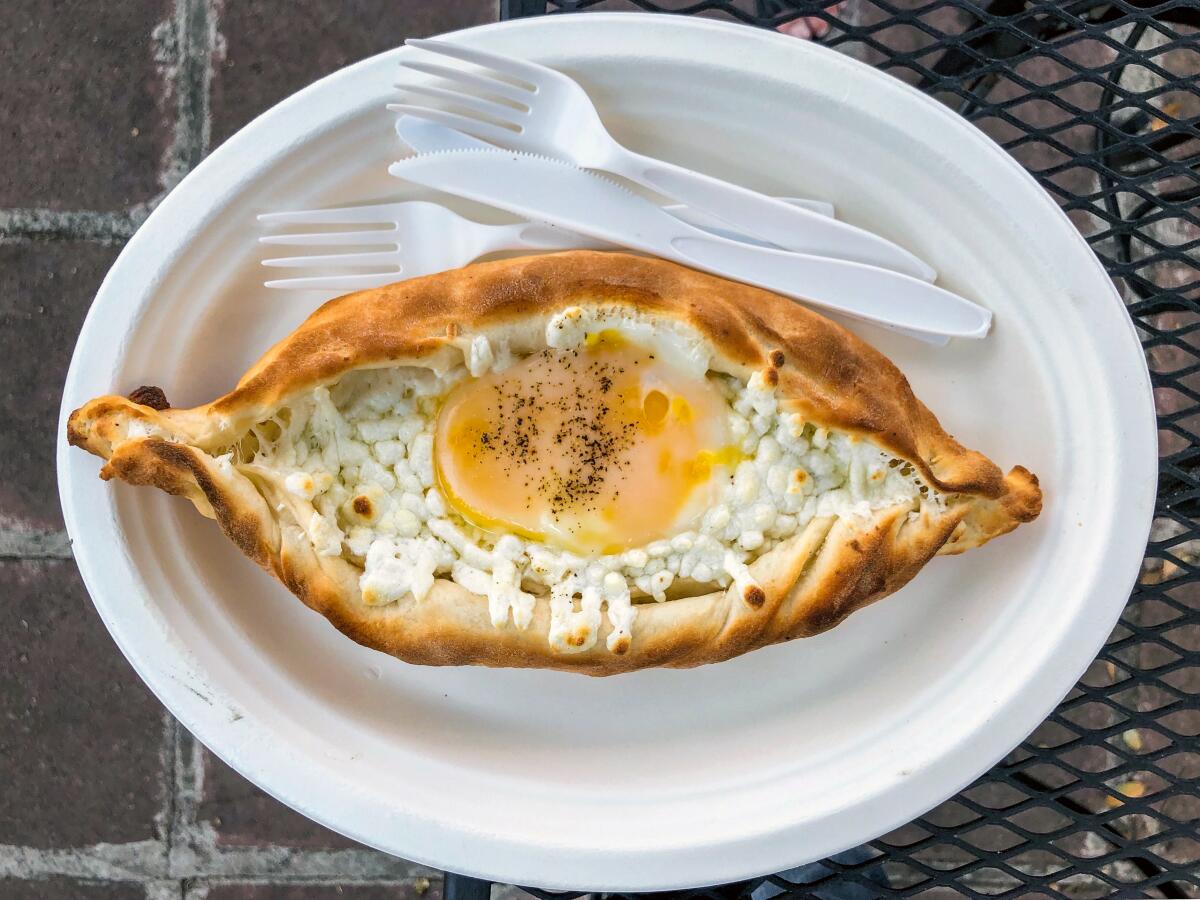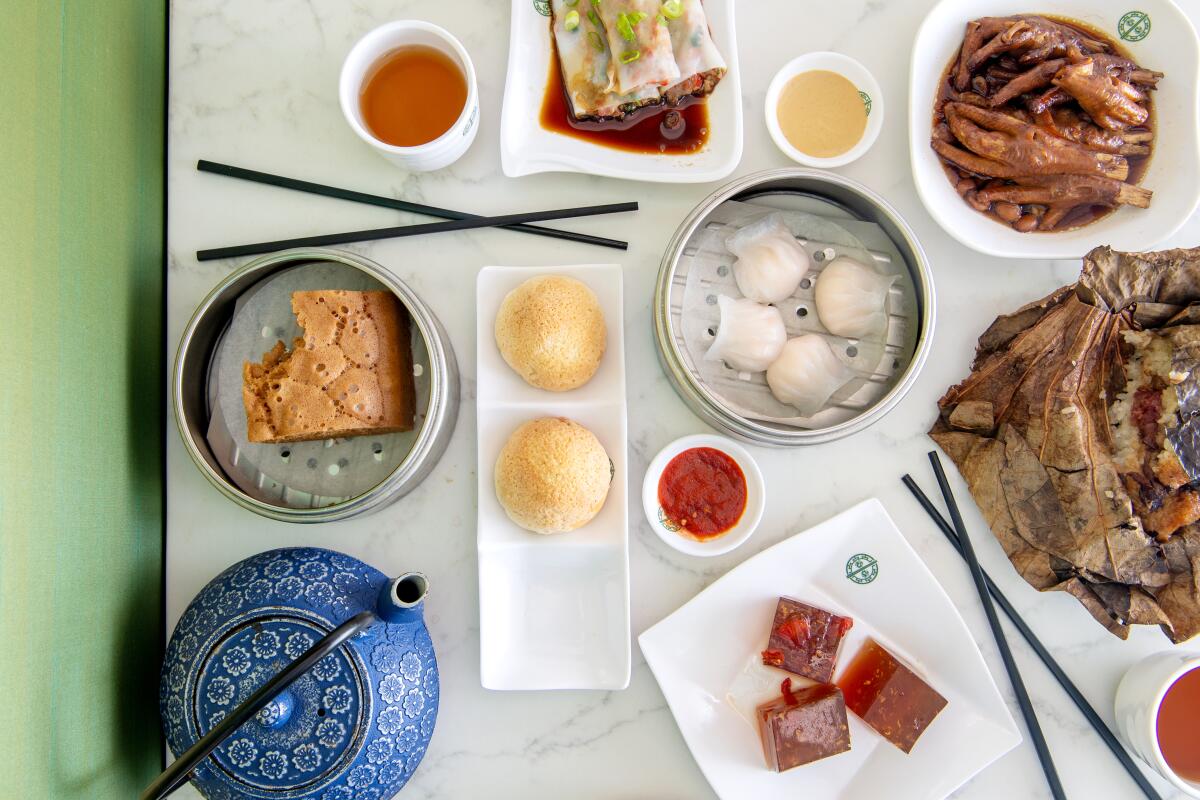Newsletter: Will everyone in America soon be eating the khachapuri cheese boat?

- Share via
The first time I pulled open the blacked-out glass door of the windowless Havlabar in Glendale — the subject of this week’s review — I didn’t know quite what to expect. The white and orange sign out front said “Georgian cuisine,” and I found myself hoping for a khachapuri cheese boat. If you follow social media food accounts or the obsession cycles of food writers, or if you frequent the Armenian bakeries concentrated in Glendale and Pasadena, you might know about this caloric gift to humanity.
The word khachapuri refers to many shapes and styles of hot cheese breads that are a staple in the Republic of Georgia. Adjaruli khachapuri, also called Adjarian or Adjaran khachapuri, is attributed to the coastal region of Adjara, an autonomous republic that borders the Black Sea. The shoreline location accounts for the attribution of the bread’s canoe-like shape, its hull filled with salty cheese; butter and an egg or egg yolk are added right after the khachapuri is pulled from the oven. Break off an edge of the browned crust and use it to stir the ingredients together into golden, molten dip; in restaurants the servers sometimes do this step tableside, which is gracious but takes away from half the fun of tackling this dish.
Oda House in Manhattan’s East Village was the first place I tried Adjaruli khachapuri — friends and I tore it to pieces in hypnotized wonder until nothing was left but oil-soaked crumbs. It was 2015, and I was having ideas that Georgia’s Silk Roads cuisine — with dishes whose ingredients and techniques can hearken to India and the Middle East, among other cultures — might be the Next Big Thing in American dining. Didn’t happen. Still could? Khachapuri certainly caught on in New York this decade, an easy-to-photograph spectacle that crept into the mainstream after being served in obscurity for years in Brooklyn’s Georgian restaurants.
Armenian cuisine embraced khachapuri, thus the cheese boat’s familiar presence in the Armenian cafes around Los Angeles. It turned out Havlabar didn’t serve Adjaruli khachapuri, though the kitchen does pull off two other compelling variations: Imeruli khachapuri (attributed to the landlocked region of Imereti in western Georgia), a round pie stuffed with mozzarella-like sulgani cheese, and a grilled version with flaky, pastry-like dough; it resembles an extra-large twisty cheese puff and is similarly irresistible.
It was gratifying to report on these versions of khachapuri. I was still hankering for the cheesy barge.
In January my colleague Jenn Harris wrote about Tony Khachapuri, Armen Piskoulian and Casey Felton’s permanent pop-up that is part of their Vietnamese-inspired sandwich shop Banh Oui in Hollywood. Piskoulian is Armenian; “tony” is a play on tone, the word for a Georgian stone oven that’s similarly shaped to the Indian tandoor.
They don’t claim to be closely hewing to tradition with their riffs on khachapuri, but this is some fun, abjectly delicious freestyling. Wade in with the “original,” three cheeses (the blend is a secret; Jenn theorized mozzarella, feta and ricotta) with one sunny egg yolk, butter and a pheromone of garlic. The build of the boat has a restrained, cru width that I appreciate; not spare but not too puffy. Its lava center blends uniformly, the consistency a couple degrees oozier than queso fundido. Score.
In the spirit of bagels, Piskoulian and Felton’s khachapuris can be ordered plain or wreathed with sesame, salt or an “everything” seasoning. I asked for za’atar sprinkled on a variation that included sliced sujuk, the spicy beef sausage. The dusky thyme in the za’atar contrasted nicely with the richness. A salad on the side might also be advisable if you’re making a lunch out of it.

Tony Khachapuri’s variations on the theme are fantastic; go try them. And yet I continued to hunger for the classic. So Jenn suggested we swing by one of her favorite Armenian cornerstones, Old Sasoon Bakery in Pasadena, for breakfast this week. Sujuk, basturma (cured beef), ham or bacon could be requested to gild the khachapuri; I wanted the straight-up standard. Old Sasoon’s blend of cheeses didn’t homogenize when mixed as much as others; I appreciated its feta-like brininess. The dough was lightly sweet, a nice touch in the morning. This one fulfilled the hankering.
(Also Jenn and I fuel each other’s gluttony and so we each ordered manaeesh — the flatbread whose name has many spellings — spread with za’atar and cheese with additions of mint, diced tomatoes, chopped green olives and onion, all rolled into a wrap. An excellent, slightly lighter breakfast option to consider.)
There’s such universal appeal to scorching bread filled with a magma of dairy and eggs, and an actual history to the dish in Los Angeles, that I can only imagine Adjaruli khachapuri becoming more commonplace. Wood, a pizzeria in Silver Lake, serves a respectful, straightforward take — the menu lists it as “khachapuri (gondola pizza)” — among its Neapolitan-style pies. That kind of direction might be safest to forecast: a trademark Georgian dish showing up alongside one of the most familiar foods in America while still, hopefully, retaining its own identity.
ASK THE CRITICS
How long does it generally take to write a review from first visit to submission?
—@thomforke, Instagram
There’s no exact set time! It’s fair to give a new restaurant about six weeks before the first official review visit; a month, absolute minimum. I then eat at the restaurant at least three times, and I do my best to space out those visits to see how the restaurant is evolving (particularly if it’s new, which applies to most of the restaurants being reviewed).
Take, for example, my review of Ceviche Project in Silver Lake. The restaurant opened in early April. I stopped by near the end of May to suss the place out: Did it merit a full review, and why? I loved the intimacy and simplicity of Ceviche Project; I thought on it and then went back in mid-June and again in early July. I turned it in to my editors on July 26 and it ran on Aug. 8.
I’m not the fastest writer by any means; I actually had nightmares about not giving myself enough time to write a more in-depth review I’m working on right now (look for it on Sept. 19). I have a busy weekend ahead.
TOP STORIES

- Guest critic Amy Scattergood reviews the first Southern California location, in Irvine, of Hong Kong-based dim sum chain Tim Ho Wan.
- Minutemen legend Mike Watt talks to Jesse Pearson about pork sandwiches, punk rock and the future of San Pedro.
- Ben Mims has all the recipes for when it’s too hot to cook (i.e., right now).
- Kae Whalen wrote a cool piece about the relationship between wine sellers and vintners, through the lens of Silver Lake’s Psychic Wines.
- Bonus: Ruth Reichl on where she likes to hide out and read.
More to Read
Eat your way across L.A.
Get our weekly Tasting Notes newsletter for reviews, news and more.
You may occasionally receive promotional content from the Los Angeles Times.










